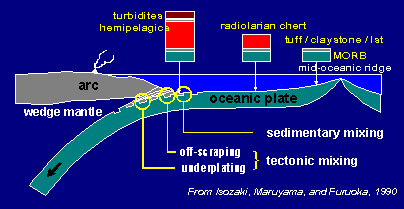


 |
Introduction & Morphology |
 |
Geological Application |
 |
Distribution in Space & Time |
 |
Glossary |
 |
Links |
 |
Home |
| | |
DISTIBUTION IN TIME & SPACE -pg 5.
 Some of the youngest productive samples are from siliceous argillite associated with fine- or coarse-grained clastic sedimentary strata. However, radiolarian chert is a rock-type resulting from the accumulation of radiolarian shells and therefore an excellent source of a diverse array of radiolarian associations.
Some of the youngest productive samples are from siliceous argillite associated with fine- or coarse-grained clastic sedimentary strata. However, radiolarian chert is a rock-type resulting from the accumulation of radiolarian shells and therefore an excellent source of a diverse array of radiolarian associations.
Most of radiolarian associations discovered in chert-bearing terranes of southern British Columbia share low paleolatitude faunal characteristics. In the cordillera, radiolarians have a large age span from the Ordivician to the Cretaceous. During the Mesozoic the marine terranes accreted onto the North American margin contained very large quantities of radiolarian bearing rocks, such as, the Cache Creek terrane which covers a 1500km stretch from southern British Columbia to the Yukon. Furthermore, an ocean basin between the Stikine terrane and the Western American margin, which is defined by large radiolarian assemblages, existed until the early Jurassic. From the Carboniferous to the Jurassic, radiolarian chert also formed the Bridge River Terrane of southern B.C. This is one of the longest accumulations of radiolarian chert known in the world and it provides evidence for the long lifespan of proto-Pacific basins. This indicates that an immense area of oceanic crust must have been subducted beneath the North American continent in Paleozoic and Mesosoic times.

Image from F. Cordey's The Rad Page (see Links)

|
| Previous Page |